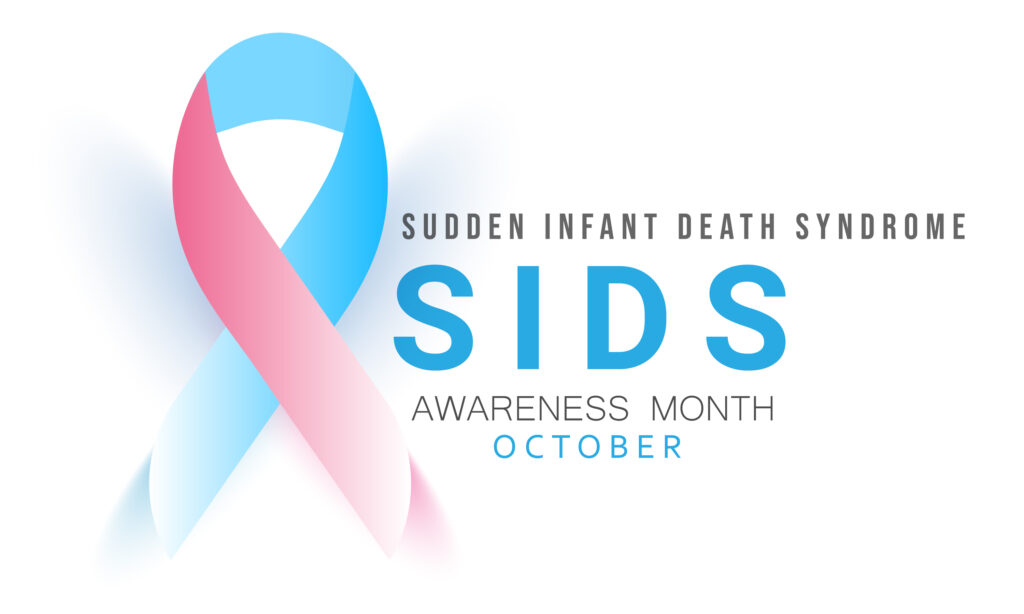It rarely happens but when it does, it is absolutely devasting: sudden infant death syndrome, or SIDS. SIDS strikes roughly 3,400 babies a year, according to the U.S. Centers for Disease Control and Prevention. A horrific and traumatic situation for family, friends, pediatricians and the community, SIDS is the term used to describe the sudden death of babies under 1 year of age.
October is Sudden Infant Death Syndrome Awareness month. As a board-certified pediatrician, I want parents and caregivers to know that, though we often don’t know what causes SIDS, there are steps they can take to reduce the chances of SIDS affecting their little one.
Babies should sleep on their backs.
The “back-to-sleep” campaign reminds us that babies should sleep on their backs, not their tummies. When putting a baby to sleep, make sure the baby is on their back until they can safely turn from back to front and from front to back on their own. (Even babies with acid reflux should sleep on their back.) When baby starts rolling on their own, you don’t need to wake up in the middle of the night to flip them back on their back. Full-term babies should be able to roll both ways by about 6 months, usually mastering back to front first and then front to back.
Babies should sleep on a firm, flat, non-inclined surface, either a bassinet, crib or play yard. Babies should not sleep in car seats (unless in the car), couches, armchairs, bouncers or swings.
Babies should not sleep with stuffed animals, blankets, quilts, bumpers or pillows.
Any of these items can pose a suffocation or strangulation hazard. Mesh bumpers are now on the market, but these, too, pose a risk. A fitted sheet is fine, but do not use a top sheet.
Babies can wear a swaddle to sleep.
Swaddles made of cotton or muslin are great choices to keep a baby warm and snug. These do not pose a hazard to safe sleeping. But once baby is rolling, they shouldn’t be swaddled.
Don’t overheat your baby.
Babies do not need fleece pajamas, blankets, hats indoors or several layers of clothing. Overheating can increase SIDS risk. If it’s cold, opt for a onesie and a swaddle.
If you share a bed with your baby, do so safely.
Though we often advise adults not to sleep with their baby, we also understand that some people may have limited space and have no choice but to share a bed with their child. We also understand that bed sharing is preferred in some cultures, and that breastfeeding moms may prefer bed sharing so they don’t need to get out of bed in the middle of the night for feeding. If you opt to share a bed with your baby, consider using a co-sleeper, which is a box that goes into the bed with the parent. It has sides that reduce the risk of the parent rolling onto the baby or the baby getting caught in the parent’s blankets. Other co-sleepers are set up right next to the adult bed, close enough for the adult to reach the baby but separate enough to ensure safety.
Caregivers should avoid tobacco smoke, marijuana smoke and illicit drugs, especially near their babies.
Exposure can increase the risk of a baby suffering from SIDS. These substances also make may make adults sleep more deeply – making them less aware if something is wrong with baby. Do not drink alcohol, smoke or use drugs during pregnancy.
Giving baby a pacifier has been shown to decrease SIDS risk.
Pacifiers can be offered for naps and nighttime sleep.
Breastfeed baby.
Studies have shown that breastfeeding your baby, even for a few months, can lower the risk of SIDS.
Don’t rely on baby monitors, pulse-oxygen readers or other devices to tell you whether baby is okay.
I understand that families want the extra reassurance these devices can provide, but they can alarm when nothing is wrong, or they may not work when something is wrong. Sound monitors and video monitors are great when the baby is in a different room, but they aren’t necessary and shouldn’t be relied upon.
Research is ongoing to understand more about who is at high risk for SIDS. The National Institutes of Health has reported that babies at high risk may have an unknown medical condition, such as problem that affects heart rate and breathing; a development period in which the body reacts in an unstable way; and be exposed to an outside stressor, such as sleeping on the stomach or being exposed to secondhand smoke.
I encourage parents and caregivers to take the steps listed above to ensure safe, restful sleeping for baby.
Adrienne Collier, MD, is a board-certified pediatrician with the Mid-Atlantic Permanente Medical Group. She sees patients at the Kaiser Permanente Bowie Medical Center.

